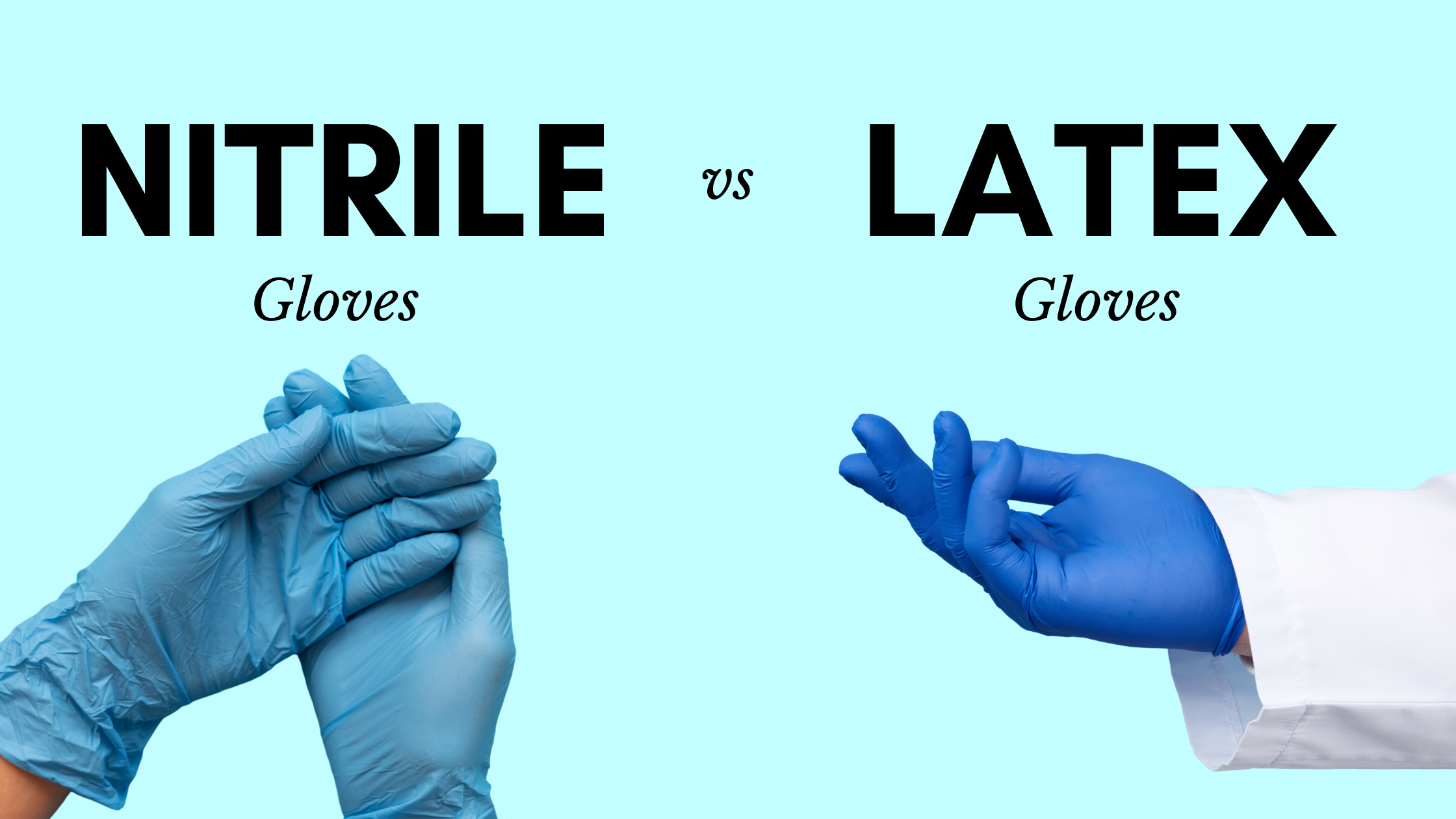Hand protection is crucial across various environments, from medical settings to industrial workplaces. Nitrile and latex gloves are the most commonly used types.
Usually, people, outside the material, are unsure about in what cases they should use them.
Let us talk about it.
Material Composition

The first thing I want to talk about is material composition.
Latex
Latex gloves are made from natural rubber sap, specifically from the Hevea Brasiliensis tree. This natural source contributes to flexibility and comfort.
The material includes natural proteins, which can cause allergic reactions in some people, and additional chemicals used during the manufacturing process to enhance durability and elasticity.
These are highly favored in medical settings due to their snug fit and superior tactile sensitivity, which is essential for tasks that require precision.
Nitrile
Nitrile gloves, on the other hand, are made from synthetic nitrile butadiene rubber. The material is a combination of butadiene and acrylonitrile, resulting in a durable and flexible one.
Nitrile is entirely latex-free, making it hypoallergenic and safe for those with latex allergies.
Over the years, the composition of nitrile gloves has improved significantly, making them more flexible and comfortable while retaining their durability and resistance to chemicals.
Chemical Resistance
Knowing all there is about the chemical resistance is an absolute must before you can choose one of these.
Nitrile
Nitrile gloves are renowned for their high resistance to a wide range of chemicals, oils, and greases.
That makes them suitable for use in environments where exposure to hazardous substances is common, such as laboratories, chemical handling, and various industrial applications.
Nitrile ones provide reliable protection against solvents, oils, and other harsh chemicals, ensuring the safety of the wearer.
Latex
Latex, in contrast, has limited chemical resistance.
They are not recommended for use with solvents, oils, or other harsh chemicals, as these substances can degrade the material, reducing its protective capabilities.
Latex gloves are more suited to environments where chemical exposure is minimal, such as general medical examinations or tasks that do not involve handling hazardous materials.
Allergies and Sensitivities

Being allergic to a material can be problematic. That is why knowing exactly what can happen should be your priority.
Latex
One of the significant drawbacks of latex gloves is the high incidence of allergic reactions.
The natural proteins in latex can trigger allergic responses in some individuals, ranging from skin irritation to more severe respiratory issues.
The powder used in some latex gloves to make them easier to don can become airborne and cause respiratory problems.
Nitrile
Nitrile gloves are a safer alternative for individuals with latex allergies.
They are free from natural proteins, significantly reducing the risk of allergic reactions.
Their hypoallergenic nature makes nitrile gloves a preferred choice in settings where glove use is frequent, ensuring the safety and comfort of all users, including those with sensitivities to latex.
Tactile Sensitivity and Comfort
Nobody likes not feeling comfortable. Therefore, knowing what makes you comfortable is a must. The truth is, you would need to try each before you can truly know.
Latex
Latex gloves are prized for their excellent tactile sensitivity and comfort.
They provide a snug fit that allows for precise movements and dexterity, making them ideal for medical settings where accuracy is crucial, such as during surgeries or detailed examinations.
The natural elasticity offers a comfortable fit, reducing hand fatigue during prolonged use.
Nitrile
Nitrile gloves offer good tactile sensitivity, though traditionally, they were considered less sensitive than latex.
Advancements in manufacturing have significantly improved flexibility and comfort.
Modern nitrile gloves can rival the counterpart in terms of dexterity and fit, making them suitable for tasks that require precision while offering enhanced durability and chemical resistance.
Durability and Puncture Resistance

Wasting money on products that will not last too long is not something people enjoy.
Nitrile
Nitrile gloves are highly durable and offer superior puncture resistance compared to latex gloves.
Their durability makes them an excellent choice for tasks that involve handling sharp objects or rough materials.
Nitrile is also tear-resistant and can reveal punctures easily, providing an additional safety feature that helps users detect when a glove has been compromised.
Latex
While latex gloves are durable, they are less resistant to punctures and tears compared to nitrile gloves.
It can be a limitation in environments where the gloves are exposed to sharp objects or abrasive materials.
Despite this, latex gloves are still widely used in many settings due to their comfort and tactile sensitivity.
Cost and Availability
Availability and costs are other major factors to take into consideration
Nitrile
Historically, nitriles were more expensive than latex gloves. That is why encountering nitrile gloves wholesale is a great chance to obtain them.
As demand has increased, particularly during global events like the COVID-19 pandemic, prices have become more competitive.
Despite the higher cost, the benefits of nitrile gloves, such as chemical resistance and hypoallergenic properties, justify the investment for many users.
However, high demand has sometimes led to scarcity and higher costs.
Latex
Latex gloves are generally less expensive than nitrile gloves, making them an economical choice for many users.
They are readily available, though their usage has been declining due to the risk of allergic reactions.
Despite this, latex gloves remain a popular choice in environments where cost is a significant consideration and where the risk of latex allergies is managed.
Environmental Impact

Due to the problems our planet faces today, being aware of the environmental impacts of the product should be a priority.
Latex
Latex gloves have a significant environmental advantage as they are biodegradable.
Being made from natural rubber, they break down more easily in the environment compared to synthetic materials.
That makes latex gloves a more environmentally friendly option, particularly for users concerned about reducing their ecological footprint.
Nitrile
Nitrile gloves are non-biodegradable, which poses an environmental challenge.
However, their necessity in applications requiring higher protection often outweighs this concern.
Efforts are being made to develop more eco-friendly nitrile options, but currently, they are not as environmentally sustainable as their counterpart.
Summary
The choice between nitrile and latex gloves depends on specific needs and environments.
Consider the pros and cons, including chemical resistance, allergy potential, and environmental impact, to select the best glove type for your requirements.







